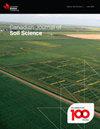Antagonistic effect of copper and zinc in fertilization of spring wheat under low soil phosphorus conditions
IF 1.5
4区 农林科学
Q4 SOIL SCIENCE
引用次数: 1
Abstract
Abstract Sound micronutrient management requires an understanding of nutrient interactions and transformation processes in soil–plant systems which can regulate bioavailability and plant uptake. A series of studies were conducted under controlled environment and field conditions to evaluate wheat response to Cu and Zn fertilization on P-deficient soils from western Canada. The grain and straw yields of wheat were reduced in two (Waskada and Tisdale) of three soils used in the controlled environment study, while yield was not affected at the Echo field site in 2016 when both Cu and Zn sulfate fertilizer were applied at 5 kg·ha–1 rates. Zinc concentration in soil and plant tissues was increased to apparent toxic levels with fertilizer addition in Waskada soils. An imbalance in tissue P:Zn concentration related to micronutrient fertilization was observed in Waskada and Tisdale soils. The availability of Cu and Zn in post-harvest soils was increased with increasing rate of these fertilizers' addition. Chemical and spectroscopic speciation using sequential extraction and X-ray absorption near edge structure, respectively, revealed that Cu and Zn were mostly speciated as carbonate phases, and complexation of these elements with carbonate and phyllosilicate minerals is likely the process controlling bioavailability in the soils.低磷条件下铜、锌在春小麦施肥中的拮抗作用
摘要良好的微量营养素管理需要了解土壤-植物系统中的营养相互作用和转化过程,这可以调节生物利用度和植物吸收。在受控环境和田间条件下,对加拿大西部缺磷土壤上小麦对Cu和Zn施肥的反应进行了一系列研究。在对照环境研究中使用的三种土壤中,有两种(Waskada和Tisdale)的小麦谷物和秸秆产量降低,而2016年,当硫酸铜和硫酸锌以5 kg·ha–1的速率施用时,Echo田地的产量没有受到影响。在Waskada土壤中,随着肥料的添加,土壤和植物组织中的锌浓度增加到明显的毒性水平。在Waskada和Tisdale土壤中观察到与微量营养素施肥有关的组织P:Zn浓度失衡。采后土壤中Cu和Zn的有效性随着这些肥料添加量的增加而增加。分别使用顺序提取和X射线吸收近边缘结构的化学和光谱形态分析表明,Cu和Zn主要以碳酸盐相的形式存在,这些元素与碳酸盐和层状硅酸盐矿物的络合可能是控制土壤生物利用度的过程。
本文章由计算机程序翻译,如有差异,请以英文原文为准。
求助全文
约1分钟内获得全文
求助全文
来源期刊

Canadian Journal of Soil Science
农林科学-土壤科学
CiteScore
2.90
自引率
11.80%
发文量
73
审稿时长
6.0 months
期刊介绍:
The Canadian Journal of Soil Science is an international peer-reviewed journal published in cooperation with the Canadian Society of Soil Science. The journal publishes original research on the use, management, structure and development of soils and draws from the disciplines of soil science, agrometeorology, ecology, agricultural engineering, environmental science, hydrology, forestry, geology, geography and climatology. Research is published in a number of topic sections including: agrometeorology; ecology, biological processes and plant interactions; composition and chemical processes; physical processes and interfaces; genesis, landscape processes and relationships; contamination and environmental stewardship; and management for agricultural, forestry and urban uses.
 求助内容:
求助内容: 应助结果提醒方式:
应助结果提醒方式:


